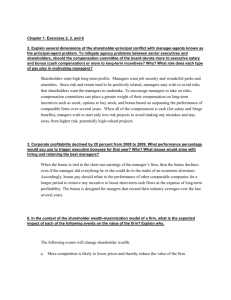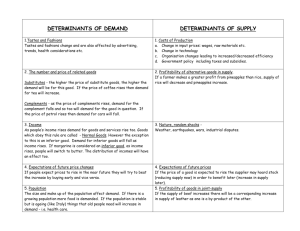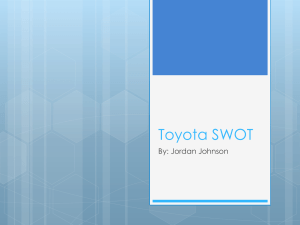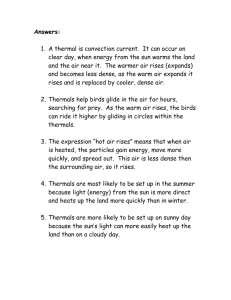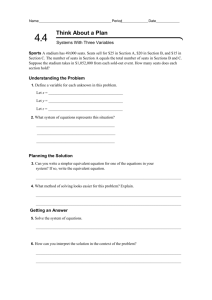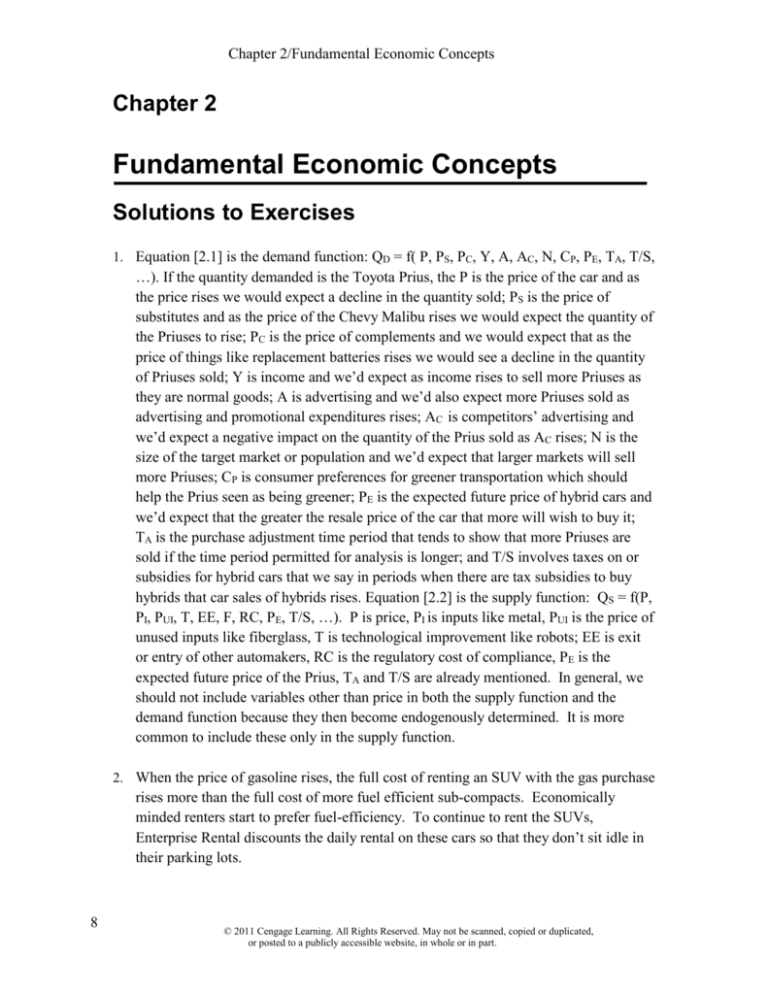
Chapter 2/Fundamental Economic Concepts
Chapter 2
Fundamental Economic Concepts
Solutions to Exercises
1. Equation [2.1] is the demand function: QD = f( P, PS, PC, Y, A, AC, N, CP, PE, TA, T/S,
…). If the quantity demanded is the Toyota Prius, the P is the price of the car and as
the price rises we would expect a decline in the quantity sold; PS is the price of
substitutes and as the price of the Chevy Malibu rises we would expect the quantity of
the Priuses to rise; PC is the price of complements and we would expect that as the
price of things like replacement batteries rises we would see a decline in the quantity
of Priuses sold; Y is income and we’d expect as income rises to sell more Priuses as
they are normal goods; A is advertising and we’d also expect more Priuses sold as
advertising and promotional expenditures rises; AC is competitors’ advertising and
we’d expect a negative impact on the quantity of the Prius sold as AC rises; N is the
size of the target market or population and we’d expect that larger markets will sell
more Priuses; CP is consumer preferences for greener transportation which should
help the Prius seen as being greener; PE is the expected future price of hybrid cars and
we’d expect that the greater the resale price of the car that more will wish to buy it;
TA is the purchase adjustment time period that tends to show that more Priuses are
sold if the time period permitted for analysis is longer; and T/S involves taxes on or
subsidies for hybrid cars that we say in periods when there are tax subsidies to buy
hybrids that car sales of hybrids rises. Equation [2.2] is the supply function: QS = f(P,
PI, PUI, T, EE, F, RC, PE, T/S, …). P is price, PI is inputs like metal, PUI is the price of
unused inputs like fiberglass, T is technological improvement like robots; EE is exit
or entry of other automakers, RC is the regulatory cost of compliance, PE is the
expected future price of the Prius, TA and T/S are already mentioned. In general, we
should not include variables other than price in both the supply function and the
demand function because they then become endogenously determined. It is more
common to include these only in the supply function.
2. When the price of gasoline rises, the full cost of renting an SUV with the gas purchase
rises more than the full cost of more fuel efficient sub-compacts. Economically
minded renters start to prefer fuel-efficiency. To continue to rent the SUVs,
Enterprise Rental discounts the daily rental on these cars so that they don’t sit idle in
their parking lots.
8
© 2011 Cengage Learning. All Rights Reserved. May not be scanned, copied or duplicated,
or posted to a publicly accessible website, in whole or in part.
Chapter 2/Fundamental Economic Concepts
3. Projects A, C, G and B require a total of $875 million in investment. Project B, the
lowest return project of this group is expected to generate an 18 percent rate of return.
Ajax can raise up to $1,050 million, with the highest cost being 18 percent for the last
$200 million. If Ajax were to choose any project beyond A, C, G, and Bsuch as
project D (the next best project after B)that project would generate a marginal rate
of return (16 percent), which is less than the marginal cost of funds needed to finance
it, in this case 18 percent for the last $200 million up to a total of $1,050. Thus, the
optimal capital budget is to invest in projects A, C, G, B, for a total of $875 million.
4. Table A.4 (p. A-8) shows Disney’s eight year annuity at a 9% discount rate is worth
5.5348 per dollar, so $6,088,280. Fox’s offer was worth $3,193,961, assuming again a
9% discount rate. CBS’s offer was worth $2,790,230, assuming again a 9% discount rate.
5. This question examines expected values, standard deviations, and risk measures for
MICHTEC’s products with probabilities of .2, .5, and .3 for boom, recession, and
normal growth.
a. Expected annual revenues = $90(.2) + $75(.5) + $85(.3) = $77.175, or as this is
expressed in millions of dollars, the expected annual revenues are $77,175,000.
b. Standard deviation of annual revenues = [(90 – 77.175)2(.2) +
(75 – 77.175)2(.5) + (85 – 77.175)2(.3) ]= 96.492063, but as this is in millions,
that is $96,492,063.
c. Coefficient of variation = v = 96.492063 / 77.175 = 0.250
6.
Comparing two projects, Project B appears riskier because it has a larger standard
deviation ($125,000) than Project A, but that does not consider relative risk.
Actually, Project A is riskier because it has a larger coefficient of variation than
Project B does.
CVA = vA = $40,000/$50,000 = 0.80
CVB = vB = $125,000/$250,000 = 0.50
Because the two projects are significantly different in size, the coefficient of
variation (a relative measure of risk) is more appropriate.
7.
General Aeronautics question involving distributions.
a.
Because the price distribution is normal, the expected price is halfway between
the most optimistic price and the most pessimistic price, or $1.5 million.
9
Chapter 2/Fundamental Economic Concepts
b.
c.
From Table 1, the z value corresponding to leaving 10 percent in the lower tail
of a normal distribution is approximately 1.28. Therefore, 1.28 standard
deviations correspond to a distance of $500,000 below the mean ($1 million
minus $1.5 million). Hence one standard deviation is equal to:
1.28 = -$500,000, or = $390,625.
z = ($1.2 million $1.5 million) / $390,625 = 0.77, so from Table 1, we can
find the p(z < 0.77) = 22.06%
Solution to Case Exercise: Revenue Management at American Airlines
1. American Airlines must learn from the past on the probability of filling seats days in
advance of the flight, for different times of the day, different days of the week, for
both business class and coach seats, and for different destinations. If too few seats in
a certain class have been sold, then the airlines many need to “sell” them to
discounters like Priceline at lower prices to fill seats. This creates price
differentiation among customers at the same class of seats. As most customers are
aware that this occurs, there is little that American Airlines need be “no shows.”
2. Trucking, health care, and hotel stays are all services. Because so much of health care
is paid for by third parties (HMOs, BlueCross, or Medicare), pricing is often obscure
to the patients so that giving a discount for a hernia surgery on Tuesdays makes little
sense. Trucking, on the other hand, is primarily Business to Business and faces a
great deal of competitive buying power (after deregulation of the trucking industry in
July 1980 with the Motor Carrier Regulatory Reform and Modernization Act reduced
the power of the Interstate Commerce Commission to set trucking rates). A firm that
does significant shipping will search extensively to find the lowest price. In this
environment, competitive rates would tend to occur. But in hotel stays, we have
small buyers of services such a traveler to show the wide range of prices found in
hotels that we also find in airlines.
3. There is an art to finding out what a customer is willing to pay. The object of the
seller is to charge the most that the customer is willing to pay. If reservation clerks or
travel agents find that customers are willing to pay more for certain upgrades, they
will allocate fewer “cheap seats” and have more “preferred seating,” or so other
designation.
10
© 2011 Cengage Learning. All Rights Reserved. May not be scanned, copied or duplicated,
or posted to a publicly accessible website, in whole or in part.

